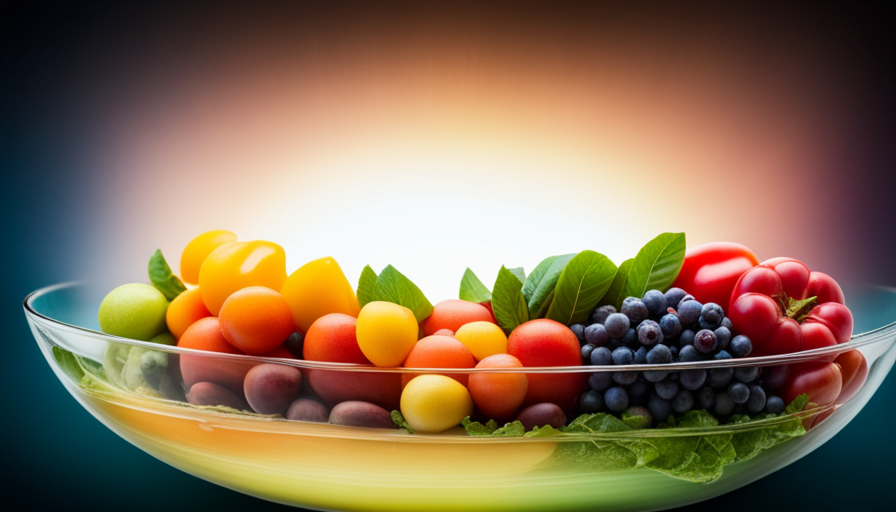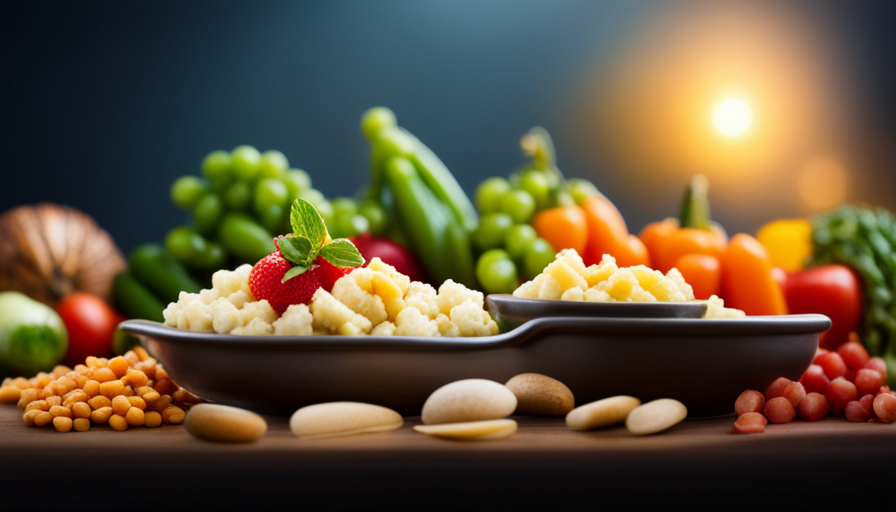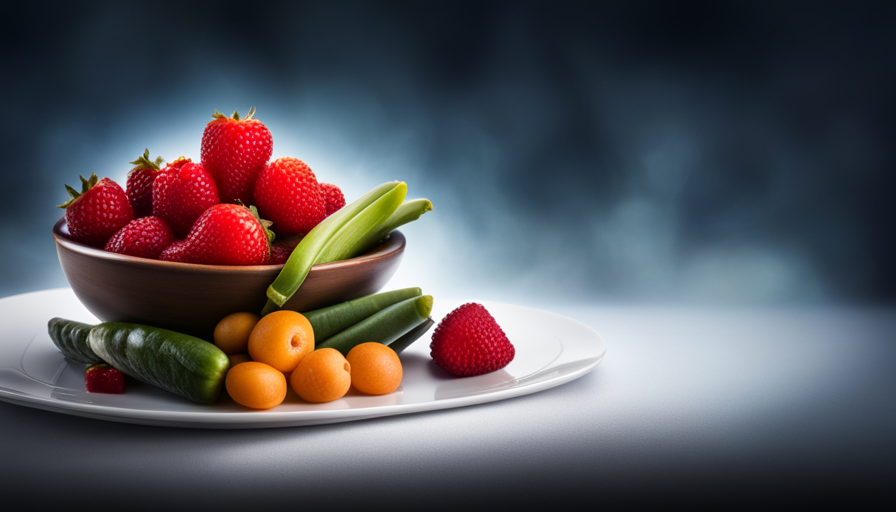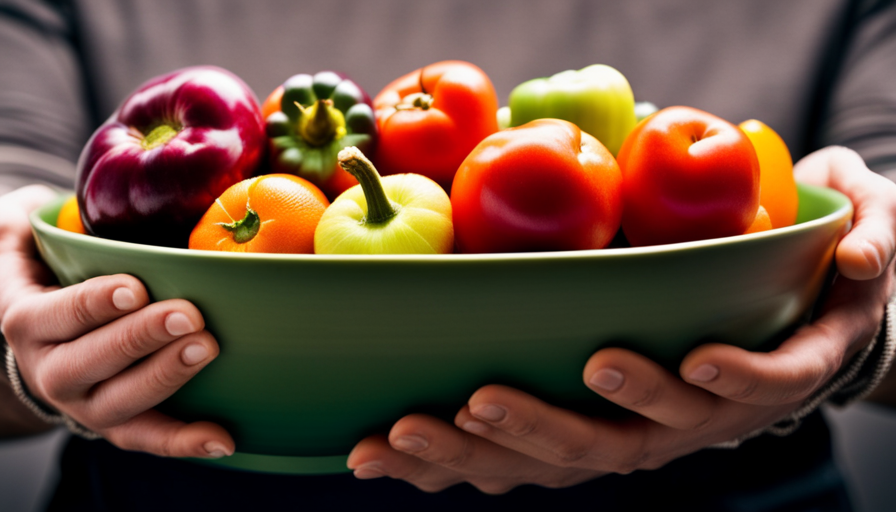Have you considered trying a 28-day raw food cleanse? You may already be familiar with detoxes and cleanses, but this could be a new and beneficial experience for you.
As a nutrition writer, I can attest to the incredible benefits that come with taking on this challenge.
Not only does it give your body an opportunity to rest and reset itself from all the processed foods we’re constantly consuming, but it also helps us become more aware of what we put in our bodies and how it affects our overall health.
In addition to providing physical benefits, such as improved digestion and mental clarity, partaking in a 28 day raw food cleanse gives us an emotional boost by helping us create healthier eating habits.
By committing to this plan for four weeks, we learn which foods make us feel alive and energized instead of sluggish and bloated – something that will stay with us long after the program is over!
Understanding The Benefits Of A 28 Day Raw Food Cleanse
We’ve all been there: Trying to make a healthy change, only to give up after a few days. But with a 28 day raw food cleanse, you can stick to it and achieve your health goals in no time.
As a nutrition writer, I am here to tell you that making this commitment is entirely possible!
The benefits of sticking to such an intense program are abundant; not only will you be taking advantage of the vitamins and minerals from eating unprocessed fruits and vegetables, but most people report avoiding hunger due to the high fiber content of their meals. You also won’t have to worry about counting calories or weighing portions – just eat until you’re comfortably full.
This way of eating does require some preparation and planning ahead though so let’s talk about what steps you need to take for success.
Preparing For The Cleanse
Now that you have become familiar with the benefits of a 28 day raw food cleanse, it is time to start preparing for the journey ahead.
This process can be daunting and staying motivated throughout the entire duration is essential. One way to keep your motivation up is by gauging your progress as you go along. Keeping track of how well you are doing in terms of following your cleanse plan or noting any changes in physical activity will help give you an idea of where you stand.
Additionally, if there are certain days when it feels like too much effort, remind yourself why this change was important to make in the first place. It may also be beneficial to find some form of support from friends or family who can understand what you are going through and cheer you on when things get tough.
Having someone who understands what type of lifestyle change you’re undertaking can be helpful during moments when staying motivated becomes difficult. If close friends or family members aren’t available, joining online groups or forums dedicated to health and nutrition can provide similar levels of support.
With preparation out of the way, now comes the task of creating a meal plan that works best for your individual needs and goals. To ensure success over the coming weeks, planning meals ahead and stocking up on ingredients so that snacking doesn’t derail progress is crucial.
Furthermore, taking some extra time to research recipes and create grocery lists beforehand could save a lot of hassle later on down the line!
Creating A Meal Plan
Tracking progress and eating out on a raw food cleanse can be challenging, but not impossible. With proper planning and preparation it is possible to sustain your lifestyle choice without compromising taste or nutrition.
As a nutrition writer, I have found that meal plans are one of the most effective methods to ensure success when beginning a new diet like this. Creating an organized plan for yourself will help you stay focused and motivated throughout the process.
Begin by writing down your meals ahead of time so that there are no surprises during the day – this will make things much easier in terms of grocery shopping as well! Make sure you factor in any events such as dinner parties where you may need to eat outside of your normal routine – having some delicious recipes ready to go will make all the difference here.
When dining out, look for restaurants with organic menu items or ones that specialize in plant-based cuisine. Ask your server if they’re able to accommodate any special dietary requests; many restaurants may even be willing to work with you directly to create something unique just for you.
Keeping track of what works best for you from experience is key, so don’t forget to take notes along the way too!
Now that we’ve covered creating a meal plan and strategies for eating out, it’s time to move onto another essential step: shopping for raw foods!
Shopping For Raw Foods
If you’re looking to save money and time on your raw food cleanse, buying in bulk is a great option. You’ll be able to purchase a large amount of food at wholesale prices, reducing the overall cost of your cleanse.
Additionally, seasonal produce is also a great way to go. It’s fresher and more nutrient-dense, plus it’ll be cheaper than buying out-of-season items. By shopping seasonally, you’ll be able to get the most bang for your buck.
Buying In Bulk
If you’re considering a raw food cleanse, shopping in bulk can be an excellent way to get the most bang for your buck. Eating seasonally also ensures that your produce is as fresh and flavorful as possible!
Bulk meal prepping helps streamline the process of eating raw foods while saving time, money, and energy along with it. When you purchase large quantities of perishable items like fruits and vegetables from local farms or farmers markets, you avoid wasting food by only purchasing what you need for each meal plan.
Plus, buying in bulk will help reduce waste since there’s no packaging involved – just natural ingredients ready to be enjoyed! With careful planning ahead of time and some creative cooking ideas, a raw food cleanse can easily become part of your weekly routine without breaking the bank.
Seasonal Produce
When shopping for raw foods, it’s important to consider seasonal availability. Buying fruits and vegetables that are in season will not only ensure you get the best quality produce at an affordable price, but also help support local farmers!
Plus, eating with the seasons means your meals can be full of flavor as well as nutrition. To make sure all your seasonal finds stay fresh while they’re stored away, take some time to familiarize yourself with proper storage tips so that nothing goes to waste.
Keeping things like berries or leafy green veggies in airtight containers and storing them on shelves within easy view is a great way to maximize their shelf life. With these simple steps, you’ll have access to delicious produce year-round – no matter what the weather brings!
Stocking Up On Pantry Basics
Now that you’ve stocked up on all the necessary raw foods for your cleanse, it’s time to make sure you have all of the pantry basics. Stocking up on these items will ensure that meal prep is easy and efficient throughout the course of your cleanse.
When stocking your pantry, there are a few great tips and tricks to keep in mind. For example, always aim to buy organic products when possible since they contain fewer additives than their non-organic counterparts.
Additionally, try to purchase items with minimal packaging as this can help reduce waste while also providing cost savings. Finally, if you’re going to be storing food for extended periods of time, consider investing in airtight glass containers as opposed to plastic bags or boxes as these prevent spoilage better.
These simple storage solutions will go a long way towards ensuring that each meal during your cleanse tastes delicious and nutritious!
As for what should actually be stored in the pantry? Essential staples like sea salt, herbs & spices, nut butters and oils are just some of the many items worth considering having on hand.
With an organized pantry full of wholesome ingredients at your disposal, understanding food combining becomes much easier!
Understanding Food Combining
It is estimated that around 70% of Americans are not following the principles of proper food combining. This statistic alone should be enough to get you thinking about how your diet could benefit from some changes in terms of meal planning and raw recipes.
Food combining means that certain combinations of foods can make them more difficult for the body to digest, thus reducing their overall nutritional value. For example, it’s best to avoid mixing proteins with starches or fruits as they require different digestive enzymes and take longer to break down, resulting in indigestion and bloating.
So when considering what food choices will go into your next cleanse day meal plan, consider which ingredients work together nutritionally before piling on plate after plate of deliciousness!
The most important thing when it comes to making healthy eating decisions is being mindful of what you’re putting into your body – both in terms of nutrition and pleasure. You don’t have to cut out all indulgent treats if they truly bring joy but try opting for healthier alternatives where possible.
Eating mindfully helps us make better choices so we can enjoy our meals without feeling guilty afterwards.
Eating Mindfully
Eating mindfully is an essential part of achieving and maintaining optimal health.
When we practice mindful eating, we make conscious decisions about the food that nourishes us based on what our bodies need in each moment.
We become aware of how or why we eat, rather than simply turning to food as a means to cope with emotional triggers such as stress or boredom.
We can learn to tune into our physical hunger cues when deciding when and what to eat instead of relying solely on external cues like meal times or diet plans.
Mindful eating also teaches us to pay attention to satiety signals so that we stop eating when full without feeling guilty for not finishing everything on the plate.
This helps reduce overeating and encourages more intuitive decision-making around food choices.
Mindful eating offers many benefits beyond weight loss, including better digestion, improved mental clarity, increased awareness of your body’s needs, reduced cravings and food preoccupation, heightened appreciation of the taste and texture of foods, enhanced self-care practices, greater satisfaction with meals eaten, and decreased feelings of guilt associated with certain foods.
Moving away from emotional eating towards making mindful decisions will help us get closer to choosing nutrient dense foods for longer lasting energy and overall wellbeing.
Choosing Nutrient Dense Foods
Mindful eating is just the first step of embracing a healthier lifestyle. Now, it’s time to take that next step: choosing nutrient dense foods for your raw food cleanse.
When selecting what to eat, we should strive to make conscious decisions about how and where our food comes from – choosing seasonally available fruit and vegetables whenever possible supports local farmers and helps reduce carbon emissions associated with transport. Additionally, by buying organic produce you can avoid exposure to pesticides which can have adverse effects on health in the long term.
Eating consciously doesn’t stop there though; being aware of portion sizes as well as taking into account all macronutrients (carbs, proteins and fats) are important considerations too – this will help ensure you stay properly nourished throughout your cleanse.
But even when you’re making smart decisions around food selection, nutrition still won’t do its job if not accompanied by adequate hydration- something that many people overlook!
Staying hydrated is essential for proper bodily functioning so keep an eye out for signs of thirst like darker colored urine or fatigue as these may indicate dehydration. Doing this will set you up for success during your raw food cleanse journey!
Staying Hydrated
Staying hydrated is a key component of any raw food cleanse. It’s important to keep your body energized and focused, so you can stay on track with all the amazing changes a raw food diet can bring.
Drinking plenty of water throughout the day will help flush out toxins, rehydrate cells, and keep digestion running smoothly. In addition to plain water, it’s also beneficial to drink fresh juices or herbal teas as they provide additional electrolytes and minerals that are lost when we sweat during exercise or just from being active in hot weather.
The best way to ensure you’re drinking enough fluids is to always have a bottle of water nearby at all times. This makes it easy for you to grab it whenever you need an extra boost of energy or if thirst strikes.
Keeping yourself well-hydrated will not only reduce fatigue but also help maintain focus and clarity throughout the cleanse process. Plus, sipping on ice cold water helps cool down your core temperature which can be especially helpful in hot climates.
It’s also essential to stay mindful about how much caffeine and alcohol you consume while doing your cleanse as these substances can act as diuretics resulting in increased urination leading to dehydration. So sip consciously!
Now let’s move onto getting creative with raw foods – there are endless possibilities when it comes to creating flavorful dishes without compromising nutrition value.
Getting Creative With Raw Foods
Raw food cleanse is like a voyage. It’s a journey that requires mindful eating and the courage to explore new ingredients and recipes. Eating raw means opening up to unfamiliar flavors, textures, smells, temperatures, and colors. It can be intimidating for some but with practice comes ease and comfort in handling uncooked foods.
To get creative with raw foods, here are a few tips:
1) Familiarize yourself with different vegetables such as celery root or jicama;
2) Play around by adding unique condiments like olive tapenade or garlic-mint chutney;
3) Experiment with various herbs and spices to add flavor while avoiding salt;
4) Try combining fruits and veggies together into salads or smoothies.
Eating raw doesn’t always have to mean crunching away at carrots all day either – there’s so much more you can do! From making your own dressings to creating veggie noodles out of zucchini – the possibilities are endless when it comes to incorporating fresh produce into your diet in interesting ways.
The next step on this journey is learning how to incorporate superfoods into meals without compromising taste or texture. With their wide range of vitamins, minerals, antioxidants, omega fatty acids, and fiber content – these nutrient dense powerhouses will help provide an extra kick of nutrition during the cleanse process.
Incorporating Superfoods
Now that you have a good foundation for your raw food cleanse, it’s time to take things up a notch and incorporate some energizing superfoods. Superfoods are nutrient-rich foods packed with health benefits that can help boost the healing process during any kind of diet or lifestyle change. By adding them into your cleanse regimen, you will be able to achieve greater emotional balance and nourishment from an array of vitamins and minerals.
| SuperFood | Purpose |
|---|---|
| Chia Seeds | High in Omega 3 fatty acids & antioxidants, promotes brain & heart health |
| Matcha Powder | Abundant source of polyphenols, improves mood and focus |
| Goji Berries | Rich in Vitamin A & C, helps protect against inflammation & supports immunity |
Not only can these delicious ingredients add flavor and variety to your meals but they also provide essential nutrients needed to support your body while cleansing. If you’re looking for an easier way to get these powerful benefits without having to shop around for different types of superfoods then consider taking supplements. Supplements made from high quality organic sources contain important micronutrients such as iron, calcium, magnesium, zinc and others which are crucial for emotional healing during a detoxification period like this one.
By making sure that you stay well-nourished throughout the duration of your cleanse, you will be better equipped to handle cravings when they arise.
Handling Cravings
Managing cravings is an important part of a raw food cleanse. The first step to managing these cravings is understanding why you are experiencing them in the first place.
Stress can be one of the biggest triggers for unhealthy eating habits, as it increases cortisol levels and causes us to reach out for comfort foods that usually aren’t very healthy. Taking time each day to de-stress through meditation or other calming activities can help reduce cravings during your raw food cleanse.
In addition to stress reduction, healing the gut microbiome with probiotics and fermented foods can also help manage cravings while on a raw food cleanse. This helps improve digestive health by restoring balance between beneficial bacteria and harmful ones in our gut. Incorporating probiotics into meals throughout the day will not only aid digestion but can also support overall wellbeing while cleansing with a raw diet.
A balanced approach to nutrition should always include attention to how different elements affect one another when consumed together. Eating nutrient dense whole foods high in vitamins and minerals will give our bodies what they need so we don’t feel like reaching for snacks all the time.
By paying attention to how stress management, healing the gut and consuming nutritious whole foods impacts our body’s needs, we can make sure we’re better equipped for success as we undertake this raw food cleanse journey. As such, working out during this period becomes even more important as it helps elevate energy levels, improves moods and regulates hormones – all essential components for optimal cleansing results!
Working Out During The Cleanse
When it comes to cravings, you’ve gone above and beyond the call of duty. Now it’s time to take your raw food cleanse up a notch by adding some extra motivation into your routine – working out!
Working out during a cleanse can be daunting, but with the right strategy in place, you’ll find yourself feeling energized and ready to tackle anything that comes your way. Exercising while on a raw food cleanse is an amazing way to boost your energy levels and help keep those pesky cravings at bay.
The key here is to make sure you are motivating workouts safely so as not to put too much strain on your body. Start slow, focusing on short bursts of activity like walking or yoga for 10 minutes a day before gradually increasing exercise duration over time. This will allow your body to adjust properly without putting any undue stress on it which could lead to injury or exhaustion down the line.
With proper nutrition and physical activity in check, you’re well-equipped to embark upon the next step of this journey: dealing with detox symptoms such as headaches or fatigue that may arise from switching onto this new diet plan. Allowing yourself plenty of rest throughout will also ensure that you stay on track regardless of how challenging things may seem initially – just remember that consistency is key when it comes to making lifestyle changes!
Dealing With Detox Symptoms
When it comes to detoxing safely, managing stress is essential.
During a day raw food cleanse, your body will be undergoing an intense elimination process in order to remove toxins from the system.
As you adjust to this change and rid your body of impurities, you may experience some uncomfortable symptoms like fatigue, headaches or digestive issues.
It’s important to recognize these effects as normal and part of the cleansing process – don’t let them discourage you from completing your cleanse!
There are several strategies that can help you manage any discomfort during the course of the cleanse.
Firstly, maintain hydration with plenty of water throughout each day and avoid alcohol consumption at all costs.
Furthermore, regular exercise such as walking or yoga can help reduce stress levels while also encouraging circulation and better digestion.
Finally, get plenty of rest and take time for yourself if needed by incorporating relaxation techniques into your daily routine like deep breathing or meditation.
By following these tips, you can ensure that your body is able to effectively eliminate toxins without feeling overwhelmed or discouraged along the way.
With proper preparation and commitment towards making positive lifestyle changes, there’s no doubt that you’ll soon start reaping the benefits of this cleanse!
Reaping The Benefits Of The Cleanse
Having successfully gone through the detox symptoms, it’s time to reap the benefits of a day raw food cleanse.
By examining lifestyle choices and discovering alternatives, you can begin your journey towards improved overall health.
Below are some of the main advantages of a day raw food cleanse:
- Improved digestion and gut health
- Enhanced energy levels
- Increased clarity and focus
- Clearer skin
- Higher intake of antioxidants from fresh fruits and vegetables
Achieving these results requires dedication and consistency; however, even one day out of each week dedicated solely to eating pure nutrition from natural sources is beneficial for the body.
It’s also important to remember that everyone reacts differently when introducing new foods into their diet, which is why listening to your body is essential in order to optimize its performance.
During this process of exploration, any underlying deficiencies or sensitivities should be addressed as soon as possible in order to get back on track with healthy eating habits quickly.
Through trial and error, anyone can find what works best for them while still achieving the desired effects by taking part in a day raw foods cleanse.
All it takes is an open mind and willingness to try something different!
Frequently Asked Questions
How Much Weight Can I Expect To Lose During The Cleanse?
It’s natural to be curious about how much weight you can expect to lose during a raw food cleanse.
While individual results may vary, it is possible to shed some pounds by changing your eating habits and meal planning.
Eating only raw foods means that you’ll likely take in fewer calories than usual, which could lead to weight loss as long as you don’t overcompensate with larger portions or snacking between meals.
However, since the goal of this type of cleanse isn’t necessarily just weight loss but also improved energy levels and overall health, focus on how the cleanse makes you feel rather than solely concerning yourself with the scale number.
Is It Safe To Do A 28 Day Raw Food Cleanse If I’m Pregnant?
If you’re pregnant and considering a 28 day raw food cleanse, it’s important to understand the potential risks.
Raw foods may not provide adequate nutrition for your body’s needs during pregnancy – or enough energy to support both you and your baby.
While some people have had successful experiences with raw food cleanses while pregnant, most experts would advise against it due to its potentially dangerous consequences.
It’s essential that you consult with a health care professional before attempting any kind of dietary change while pregnant.
Can I Still Drink Coffee While On The Cleanse?
I know the feeling – you’re on a mission to cleanse your body through replacing meals with raw foods, but coffee is one of those things that’s hard to let go.
Well, coincidentally enough there are ways to still enjoy it while reaping all the fasting benefits from a 28 day raw food cleanse. Yes, even when pregnant!
Nutritionists suggest that if you can’t give up caffeine entirely, try substituting caffeinated drinks for decaf versions instead.
This way you get some of the flavor and ritual without overloading yourself with too much caffeine.
Should I Take Any Supplements While On The Cleanse?
It’s important to consider whether you need any additional supplements while on a cleanse.
Eating habits and meal planning are key components of achieving the desired outcomes of a raw food cleanse.
The type, quantity and quality of your intake during this period should be carefully monitored as it will significantly impact how effective the cleans is for you.
If you find yourself lacking in essential vitamins or minerals due to dietary restrictions, then taking a supplement can help fill that gap.
However, it’s always best to consult with your doctor before making any changes to your diet – even if it’s just for a short-term cleanse!
Are There Any Foods That I Should Avoid While On The Cleanse?
If you’re considering a raw food cleanse, one of the most important things to remember is what not to eat!
Eating out can be tricky – but it’s doable. So don’t feel like you have to stick with salads; just make sure that your food choices are still within the confines of the cleanse.
Avoid processed foods and those high in sugar or salt as these won’t help you reach your goals for this 28-day journey.
Remember: The key is to listen to your body and find out what works best for you.
What Are the Benefits of Extending a Raw Food Cleanse from 28 Days to 30 Days?
Extending a 30 day raw food cleanse to 28 days offers additional time for the body to detoxify and reset. This extra two days can lead to more significant weight loss, improved digestion, increased energy levels, and clearer skin. The extended cleanse allows for a deeper cleansing and greater overall health benefits.
Conclusion
The 28 day raw food cleanse is a great way to jumpstart your body and give it the reset that it needs.
It’s important to do your research before embarking on this journey, as there are certain risks involved with any kind of cleanse.
But by being mindful of what you’re eating and taking care to avoid foods that could be dangerous for your health, you can make sure that the experience is both safe and effective!
Ultimately, if done correctly, the rewards from completing a raw food cleanse will be well worth it – feeling revitalized and energized in ways like never before!
So take the plunge into the unknown with confidence – even though it may feel daunting at first, trust me when I say that you won’t regret it.









